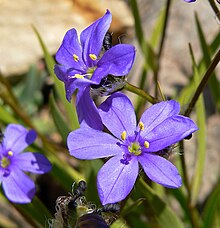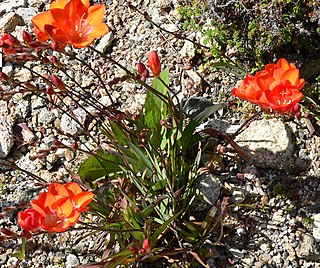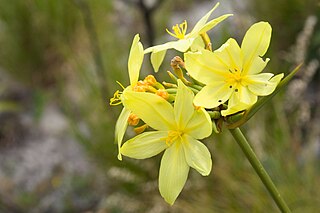| Aristea | |
|---|---|
 | |
| Aristea africana | |
| Scientific classification | |
| Kingdom: | Plantae |
| Clade: | Tracheophytes |
| Clade: | Angiosperms |
| Clade: | Monocots |
| Order: | Asparagales |
| Family: | Iridaceae |
| Subfamily: | Aristeoideae Vines |
| Genus: | Aristea Sol. |
| Type species | |
| Aristea africana (L.) Hofmannsegg | |
| Synonyms [1] | |
| |

Aristea is a genus of evergreen, perennial and rhizomatous species of flowering plants in the family Iridaceae, first described in 1789. The genus is distributed in tropical and southern Africa, as well as Madagascar. [1] The genus name is derived from the Greek word arista, meaning "awn". [2]
- Species [1] [3]
- Aristea abyssinica Pax
- Aristea africana (L.) Hoffmanns.
- Aristea alata Baker
- Aristea anceps Eckl. ex Klatt
- Aristea angolensis Baker
- Aristea angustifolia Baker
- Aristea bakeri Klatt
- Aristea bequaertii De Wild.
- Aristea biflora Weim.
- Aristea cantharophila Goldblatt & J.C.Manning
- Aristea capitata (L.) Ker Gawl.
- Aristea cistiflora J.C.Manning & Goldblatt
- Aristea cladocarpa Baker
- Aristea compressa Buchinger ex Baker
- Aristea cuspidata Schinz
- Aristea dichotoma (Thunb.) Ker Gawl.
- Aristea djalonis A.Chev. ex Hutch.
- Aristea ecklonii Baker
- Aristea elliptica Goldblatt & A.P.Dold
- Aristea ensifolia J.Muir
- Aristea fimbriata Goldblatt & J.C.Manning
- Aristea flexicaulis Baker
- Aristea galpinii N.E.Br. ex Weim.
- Aristea glauca Klatt
- Aristea goetzei Harms
- Aristea grandis Weim.
- Aristea humbertii H.Perrier
- Aristea inaequalis Goldblatt & J.C.Manning
- Aristea juncifolia Eckl. ex Baker
- Aristea kitchingii Baker
- Aristea latifolia G.J.Lewis
- Aristea lugens (L.f.) Steud.
- Aristea madagascariensis Baker
- Aristea montana Baker
- Aristea monticola Goldblatt
- Aristea nana Goldblatt & J.C.Manning
- Aristea nigrescens J.C.Manning & Goldblatt
- Aristea nyikensis Baker
- Aristea oligocephala Baker
- Aristea palustris Schltr.
- Aristea parviflora Baker
- Aristea pauciflora Wolley-Dod
- Aristea platycaulis Baker
- Aristea polycephala Harms
- Aristea pusilla (Thunb.) Ker Gawl.
- Aristea racemosa Baker
- Aristea ranomafana Goldblatt
- Aristea recisa Weim.
- Aristea rigidifolia G.J.Lewis
- Aristea rupicola Goldblatt & J.C.Manning
- Aristea schizolaena Harv. ex Baker
- Aristea simplex Weim.
- Aristea singularis Weim.
- Aristea spiralis (L.f.) Ker Gawl.
- Aristea teretifolia Goldblatt & J.C.Manning
- Aristea torulosa Klatt
- Aristea zeyheri Baker















